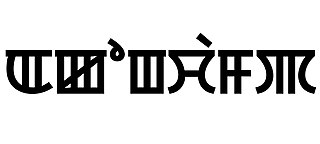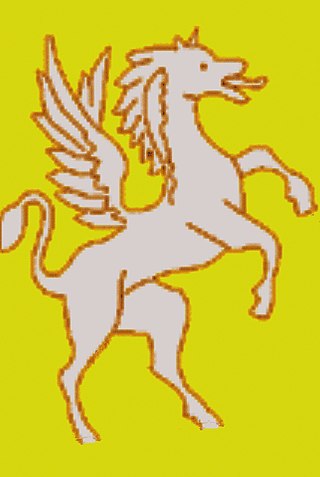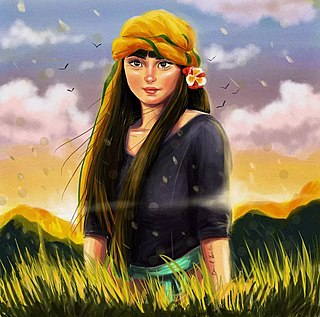
Meitei literature, also known as Manipuri literature, is literature written in the Meitei language of Manipur. An ancient institution of learning, the Luwang Nonghumsang, later known as the Pandit Loishang, collected sources of indigenous Meitei knowledge and philosophy until the 18th century. Writing by Meiteis is assumed to go back to the Kingdom of Kangleipak in the early 12th century. The Meitei script is a Brahmic abugida. It is known only from the Puya manuscripts discovered in the first half of the 20th century. Manuscripts of the 18th and 19th centuries were written using the Bengali alphabet. The existence of the Meitei script in the 15th-century hinges on the authenticity of an inscription dated to the reign of Senbi Kiyamba. The first printed Manipuri book, Manipurer Itihas, appeared in 1890 from the Baptist Mission Press, Calcutta. Though the kings of Manipur had established contact with the British from the middle of the eighteenth century onward the real impact of the contact came much later. Johnstone Middle English School, based on the western system of education, was started in 1885 at Imphal, and in 1891 Manipur lost its independence to the British. British domination facilitated the introduction of new systems in the civil, political and educational spheres, which hastened the process of modernization in Manipur, exposed as it was to new ideas and influences.

Poubi Lai was an ancient dragon python, who dwelled in the Loktak Lake of Manipur, in Meitei mythology and folklore. It is also referred to as "Loch Ness Monster of Manipur".

In Meitei mythology and religion, Nongthang Leima is the goddess of seduction, thunder, and lightning. She was created by Atingkok to attract Haraba (Pakhangba). She mastered thunder and lightning in the chaos in the early world. She predicted the first rain. She limits the chaos and helps creation.

Nongpok Ningthou, also known as Sovereign of the East or King of the East, is a deity in Meitei mythology and religion of Ancient Kangleipak. He is the ruling guardian deity of the eastern direction. Legend says Nongpok Ningthou and Panthoibi got united in the Nongmaiching mountains. Later, they were worshipped as the civilization giving deities in Meitei religion.
Lourembam Bino Devi is a practitioner and a popularizer of the appliqué art of Manipur called Leeba in the Meitei language. The Leeba art is used in creating Monmai which is a decorative circular appliqué art piece used in covering both ends of the traditional Manipuri bolster pillow. In the olden days, Leeba was practiced at "Phiribi Loishang", which is a house for maintaining clothes worn by the deities and royals. The apparels used by the royals, including shoes, were mostly designed using the Leeba technique. Bino Devi has devoted her life to practice this art form and to revive it by trying to transmit her skills to younger generation of interested women. She has been providing this training in collaboration with the Heritage Foundation of Mankind, a Non-Governmantal Organization located in Imphal. She has also conducted several workshops at Imphal and at various other places in India.

Khoriphaba is a God in Meitei mythology and religion of Ancient Kangleipak. He is the son of Sky God Salailen and Goddess Konthoujam Tampha Lairembi. He came down from heaven to earth to search for his mother and then for a bride. He is best known for wrestling with Loyalakpa in the Lai Haraoba festival. He is also a polo playing God.

Phouoibi (Fouoibi) or Phouoipi (Fouoipi) or Phouleima (Fouleima) or Phoureima (Foureima) is the goddess and the female personification of the agriculture, crops, fertility, grains, harvest, paddy, rice and wealth in Meitei mythology and religion of Ancient Kangleipak (early Manipur). She is the lover of Akongjamba, a hero in ancient legends. But fate does not permit the lovers to unite. So, Phouoibi and Akongjamba reincarnated in the legends. She was sent by Thangching (Thangjing) to Kege Moirang (Keke Moilang) kingdom to prosper the human world. The legends of her love with Akongjamba were believed to be enacted by Thangching (Thangjing) as a part of the Epic cycles of incarnations (Moirang Saiyon) of the Moirang Kangleirol legends.

Lemlei Ngaleima or Ngareima is the goddess and the divine female personification of the fishes and the aquatic life in Meitei mythology and religion (Sanamahism) of Ancient Manipur. She is a sister of the goddesses, Phouoibi, Thumleima and Ereima (Ireima).

Akongjamba was a nobleman of a king in Ancient Moirang in Meitei mythology and folklore. He was a lover of the harvest Goddess Phouoibi. According to mythology, fate did not permit the lovers to unite, so they reincarnated. The lives of the two legendary lovers were believed to be enacted by Thangjing as a part of the epic cycles of incarnations.

Korouhanba is the God of the Sun, the Sky and the Heaven in Meitei mythology and in the religion of Ancient Kangleipak. He is also known as Taohuireng and is one of the two sun brothers in the Numit Kappa epic legend. He is also called "Ngantureng" because of his ability to remove darkness. He is described as "Songbu Chiraitangba" — a physician who is bald headed.

Khamlangba, also spelt as Khamlangpa, is a deity in Meitei mythology and religion of Ancient Kangleipak. He is the God of iron, mining, metallurgy, steel manufacturing, hunting and war. His occupation is the extraction of the iron ores and the manufacture of steel. The Khamlangba Thenlon text mentions about his skills of iron metallurgy and blacksmith in ancient Kakching kingdom.

Loyalakpa, also spelt as Loyarakpa, is a God in Meitei mythology and religion of Ancient Kangleipak. He is best known for wrestling with Khoriphaba during the Lai Haraoba festival. He is the consort of goddess Thoudu Nungthel Leima. He is one of the ten kingly gods in Meitei religion.

Pureiromba is a God in Meitei mythology and religion. He is the giver of rain and agricultural prosperity. He is one of the major Umang Lai deities. He is the Ancestor God of the Angom clan of the Meitei ethnicity.

Meitei mythology or Manipuri mythology is a collection of myths, belonging to the religious and cultural traditions of the Meitei people, the predominant ethnic group of Manipur. It is associated with traditional Meitei religion (Sanamahism). Meitei myths are a part of Meitei culture and explain various natural phenomena, how the human civilization developed, and the reasons of many things happening. Most of the Meitei legends are found in the Meitei language texts.

Thangching or Thangjing is a primordial deity in Meitei mythology and religion of Ancient Kangleipak. He is the ruling deity of the Moirang dynasty of Ancient Moirang. He rules supreme on the banks of the landlocked sea, Loktak lake. He is one of the four cardinal Umang Lais. The guardianship of the south western direction is alluded to Thangjing and the other directions to Koubru, Marjing and Wangbren.

Wangpulen is the god of water, rain, flood, disease and sickness in Meitei mythology and religion of Ancient Kangleipak . He is the ruler of the underwater world. He is the Lord of the rivers. The guardianship of the south eastern direction is alluded to Wangbren and the other directions to Koupalu, Marjing and Thangjing. He is one of the Umang Lais.

The Tales of Kanglei Throne is a book by Linthoi Chanu. It is published by the Blue Rose Publisher in December 2017. It deals with the mythological and historical events of Kangleipak (Manipur) from the prehistoric times upto the seventh century. The Kanglei realm (Kangleipak), an antique name of Manipur, emerged as a well established kingdom in the year 33 C.E. Two historical personalities, "Chingkhong Poireiton" and "Nongda Lairen Pakhangba" founded the civilization of Ancient Kangleipak, whose main feature was the ideological system of kingship and royalty, having Nongda Lairen Pakhangba as the first king to sit on the throne of Kangleipak.

In Meitei mythology and folklore, the epic cycles of incarnations in Moirang is a cyclic epic of seven incarnations of two divine lovers in the kingdom of Moirang in the realm of Ancient Kangleipak.

Samaton (/saa-ma-ton/) or Samadon (/saa-ma-don/) is a fictional winged divine horse in Meitei fiction. He is one of the most recognised creatures in Meitei fiction.Devi, Dr Yumlembam Gopi. Glimpses of Manipuri Culture. Lulu.com. ISBN 978-0-359-72919-7.Chandra, Yashaswini (2021-01-22). The Tale of the Horse: A History of India on Horseback. Pan Macmillan. ISBN 978-93-89109-92-4. Legend says that Samaton is the ancestor of the present day Manipuri pony. The Leithak Leikharol describes Samaton as a primordial horse associated with Meitei cosmology.It is created by Sanamahi to attack on Pakhangba. Later, it became the mounting creature of God Marjing. It is also called "Shamadon Ayangba" or "Shamaton Ayangpa" due to free variation of words in Meitei language.

Women have significant roles in different elements of Meitei culture, including Meitei dances, Meitei festivals, Meitei folklore, Meitei folktales, Meitei literature, Meitei mythology, Meitei religion, etc.











